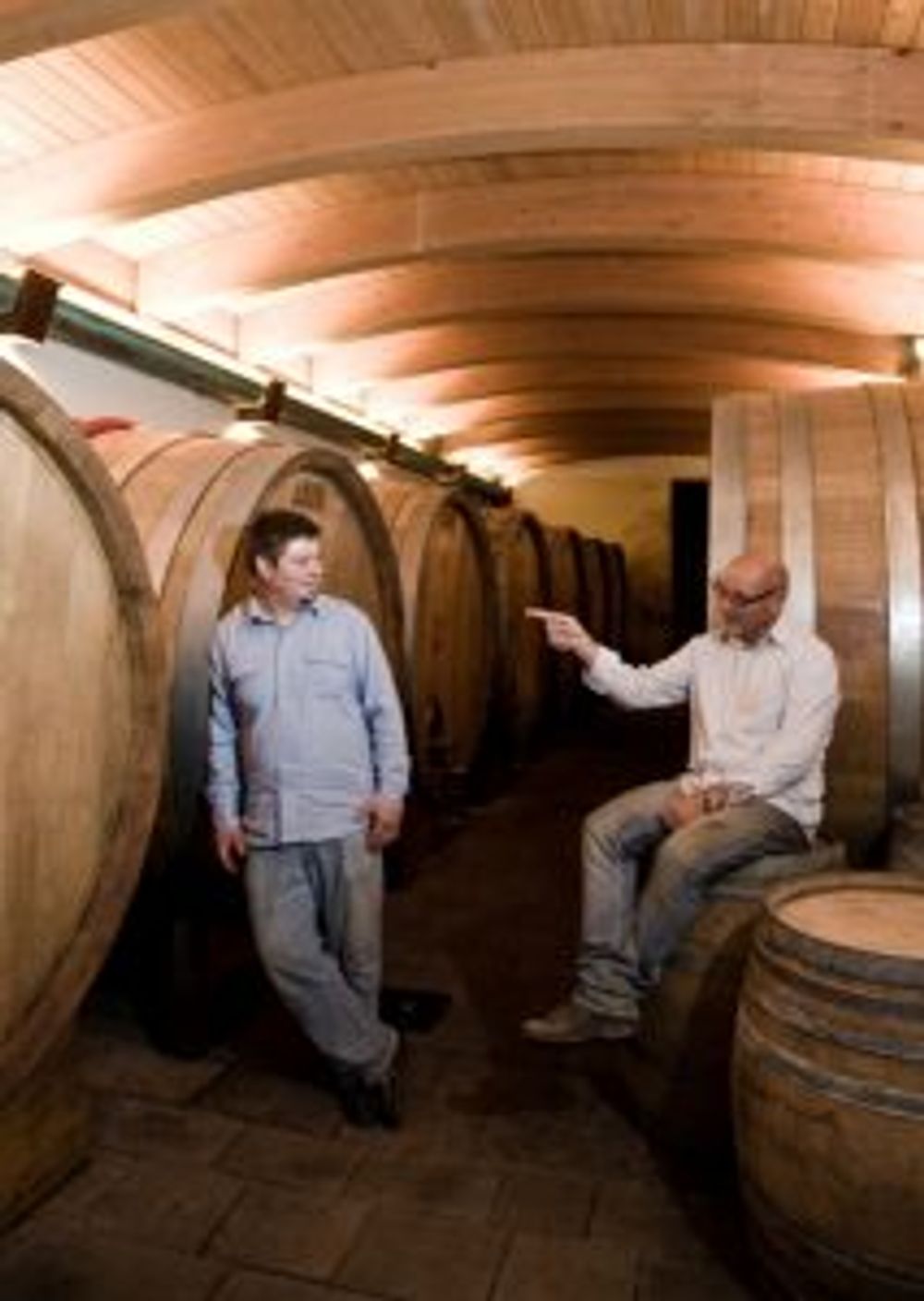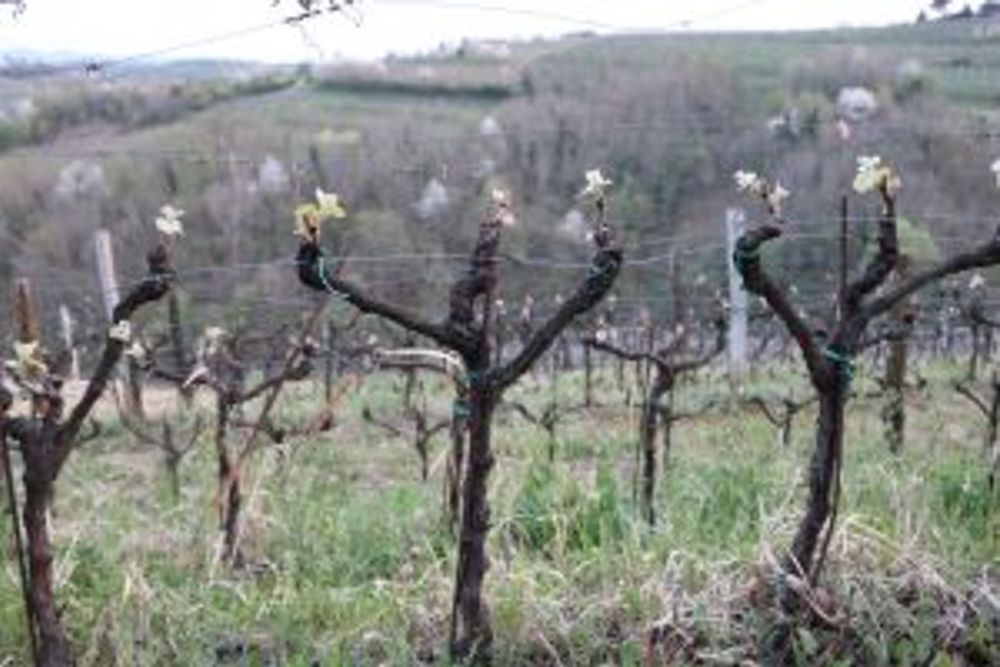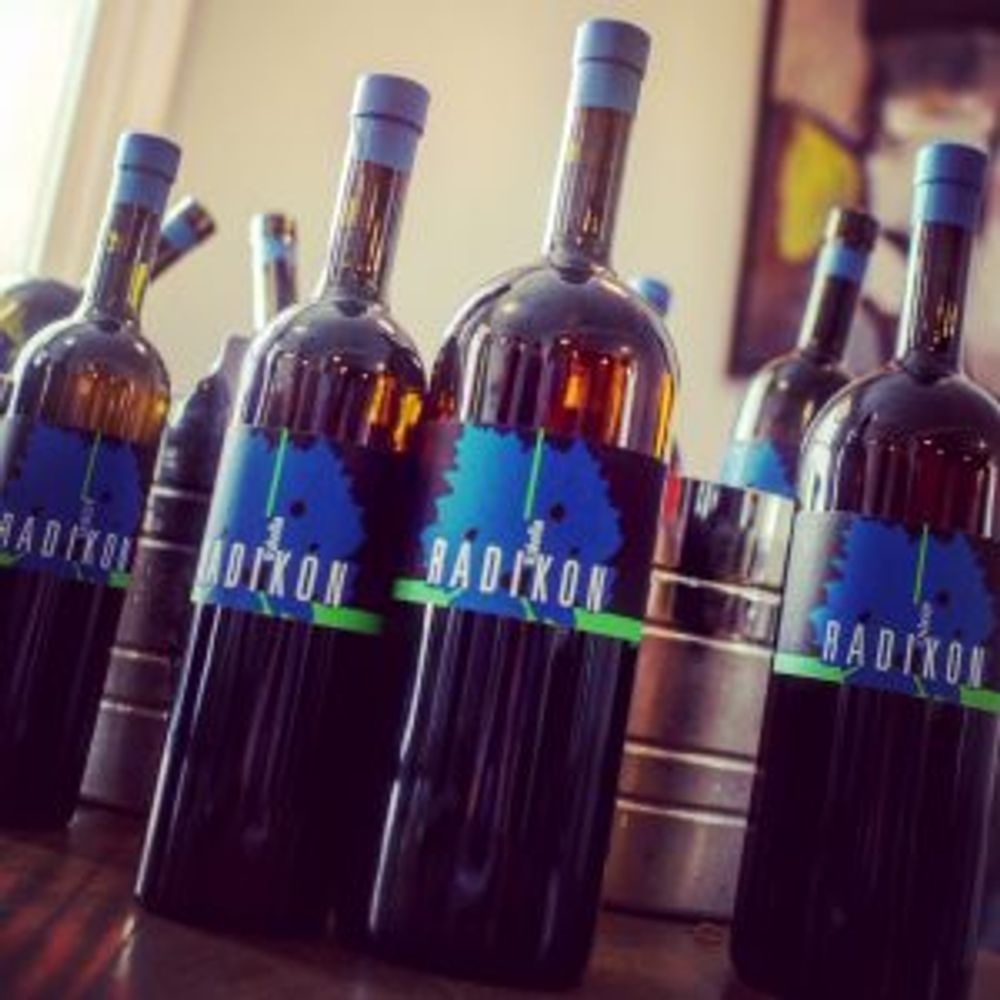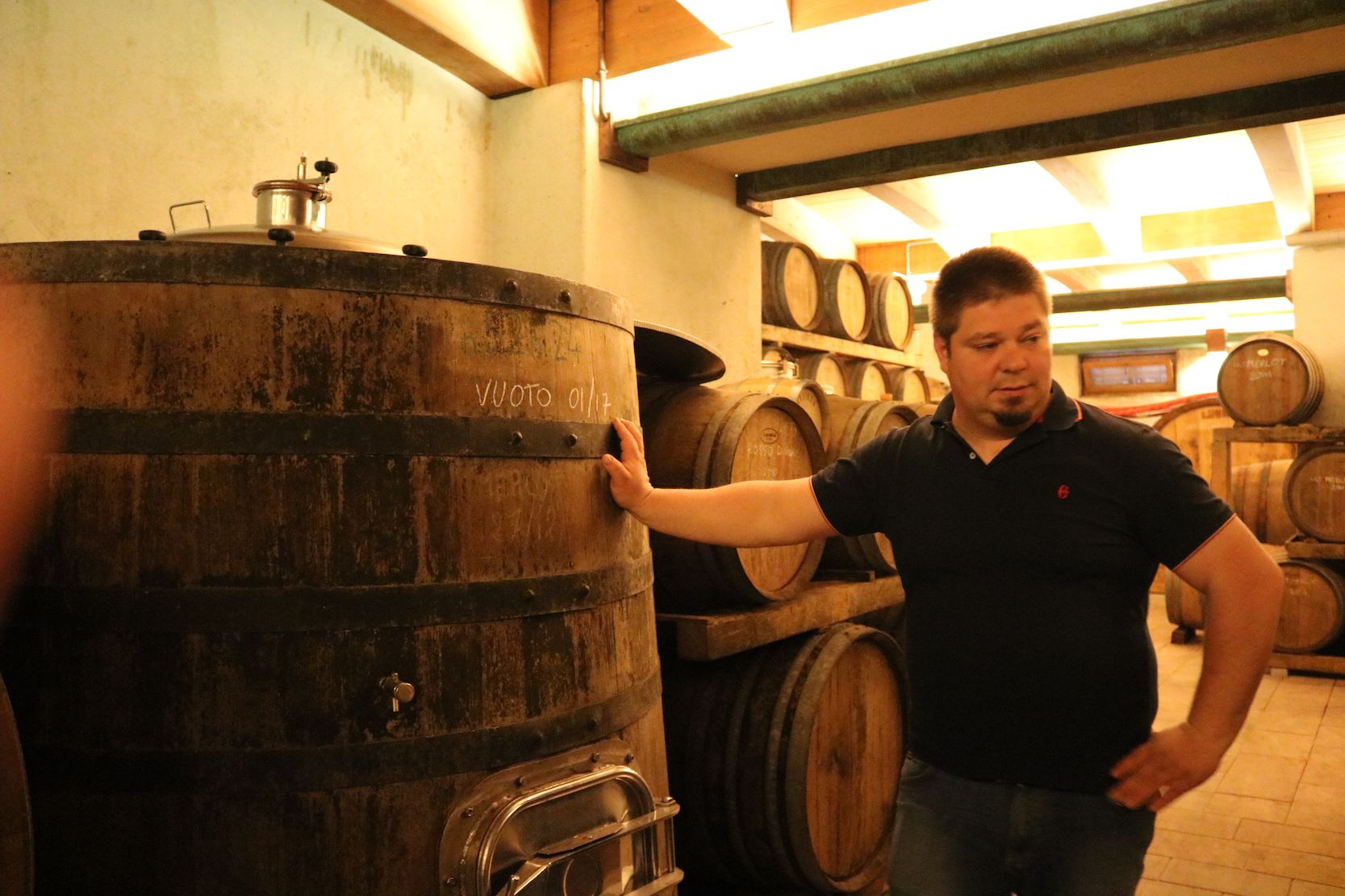Five whites and three reds tasted (with full tasting notes), but first meeting up with Saša Radikon to find out why the winery is so important to today’s young winemakers
Every now and then you get the rare opportunity to meet one of your heroes. For some people, this may be a sportsman, or a film star, but for me it’s nearly always a winemaker. This time it was Saša Radikon.

Saša with his father Stanko in the cellar
Saša’s father, Stanko, was one of the first wave of winemakers to really ‘break the mould’ of what had gradually become the norm of modern day winemaking, and to rewind his white wines to use the winemaking techniques of the past, using long periods of skin maceration.
This has since been emulated, and today we see this becoming a popular style amongst new wave and young natural winemakers around the world. He sadly passed away last year, but leaves the domaine in the more than capable hands of his son Saša, his mother Suzana and their family.
The Radikon story began in the early 1900s, when the family vineyards in Friuli were planted with the indigenous Ribolla Gialla variety by Stanko’s grandfather, Franz Mikulus. His parents took over the domaine in 1948 and increased plantings to include Merlot, Tocai Friulano (another indigenous varietal, also known as Sauvignon Vert), and Pinot Grigio. The winery now consists of approximately 12 hectares, planted on steep slopes, with soils consisting predominantly of Eocene marls.

Stanko produced 36 vintages up until his death. His winemaking during this period altered drastically, returning to the aforementioned winemaking style of his grandfather, predominantly for his Ribolla Gialla.
In 1995, he decided to reintroduce this long skin contact maceration in his wines and abandoned the use of all chemicals, which at the time was fairly controversial. His reasoning was that, for skin contact wines, where the skins play the fundamental part in the wine, the juice could not be macerated if pesticides were present on the skins. This skin contact advanced as time went on, with many of his cuvées now seeing 30 days on the skins.

He also revolutionised bottling – disusing the standard 750ml bottles in favour of 500ml and 1L bottles – due to his belief that 750ml is rarely the correct amount to drink. With the 500ml bottles, it becomes possible to dine as two, with one bottle of white and one of red. He also altered the bottleneck size and cork size, favouring a more narrow style, which the Radikon family believes to provide the ideal surface-to-air ratio for ageing conditions.
Asking him what he thought of the 500ml bottles and their ageing potential, Saša mused, “They’re good, but the small bottles are designed for earlier drinking – the wines age similarly up until four years in the bottle, where a subtle difference is noted with the litre bottles after this.”
Tasting the Radikon wines with Saša

Saša Radikon
The Radikon tasting was held at the Soho natural wine bar and restaurant, Antidote, showcasing the cuvées which Dynamic Vines import.
All wines are aged in large 3,500L neutral oak foudres (no toast) specifically purchased for the Radikon wines, as they are almost impossible to find. All wines use destemmed fruit (it is too cold in the region to ripen the stems), fermented naturally with indigenous yeasts and no sulphur additions at all.
White wines
2015 IGT Venezia Giulia “Pinot Grigio”
Pinot Grigio
10 days skin contact, with 18 months ageing, for both this wine and the Slatnik.
NOTES – The wine has prominent red berries on the palate – raspberries and fresh cherry skins, with some subtle blossom notes. On the palate, it has tightly wound white peach flesh and peach skin notes, with a lovely fresh, floral finish with some lifted sour raspberry notes. A gorgeous, fresh, pure and approachable wine – arguably the easiest to drink of the range.
2015 IGT Venezia Giulia “Slatnik” (single vineyard)
Chardonnay, Tocai Friulano
The blend here is 80/20, and varieties are co-fermented. I asked about the Tocai and its role in the wine, to which Saša smiled and shrugged, “it adds something magic.”
NOTES – On the nose, the wine has a distinctive herbal edge – reminiscent of some minty herbs, with some dried flowers and almost a haylage edge. On the palate, it has headier notes of yellow peaches, again peach skin, as well as some dried apricot.
2010 IGT Venezia Giulia “Oslavje”
Chardonnay, Sauvignon Blanc
The same blend as the iconic Fuori dal Tempo – I had the pleasure of drinking the 2001 recently, a seriously magnificent wine that is etched in my memory. The Fuori dal Tempo comes from a selection of one single vineyard, of which the remainder goes into the Oslavje. In addition, another vineyard contributes to this blend. This wine sees three months skin contact, four years in oak and two further years in bottle.
NOTES – A heady nose of honey blossom with some wildflower notes and dried herbs – thyme and rosemary. The wine evidently develops in the glass with oxygen and moved towards the fruitier end of the spectrum showing fresh pineapple, stone fruits and red apple on the palate, with that distinctive long and lean mineral edge.
2010 IGT Venezia Giulia “Ribolla Gialla”
Ribolla Gialla
Here we have the Ribolla grape – Saša’s favourite to work with due to it being both “traditional and versatile” if handled correctly.
The youngest vines are 12 years old, and vine age averages at between 45 and 50 years old. Saša stated that it is hard to find older vines, due to the majority unfortunately having been destroyed in the first world war.
NOTES – strikingly bright on the nose, with lemon rind and lime rind shining through, again with a herbal edge of spearmint, lavender and fresh green leaves. On the palate, it is tannic – grippy and laden with citrus notes – lemon, lime, grapefruit and orange rind, with some subtler rosemary sprigs and some kumquat hints on the finish. I love this.
2010 IGT Venezia Giulia “Jakot”
The wine takes the name Jakot (Tokaj spelled backwards) due to Italian regulations no longer permitting the use of the word for the variety, instead only allowing Friulano, which to the Radikon family means nothing – this is not the grape they know it to be. It was Saša’s mother, Suzana’s, idea to give the wine this name. It stuck, and today certain winemakers approach the Radikon family to use the name themselves, with a handful labelling their own cuvées Jakot after this groundbreaking wine, seeing a new family of Jakot wines emerge…
I asked Saša what his own favourite wine to vinify is, to which he replied, “usually the Ribolla Giallas, but this cool vintage was really special for the Jakot.”
NOTES – A particularly perfumed nose, with a botanical oil nose. On the palate, it shows a herbal savoury edge and burnt lemon rind, developing to dried apricots and almonds, and a very unique distinctive round, supple, linear texture. The Radikon range is highly unique in itself, but this wine is specifically so.
Speaking to Saša about Ribolla and Tocai, he explained that Ribolla can be difficult and “must be planted at the top of the slopes,” needing long sunlight hours to ripen, but not necessarily warmth. It is typically harvested mid-October, the last of the whites. Meanwhile, Tocai handles humidity well and likes to be planted in “fresh” cold places, suiting the lowest parts of the slopes, thus performing exceptionally well in this wet vintage. It naturally has higher alcohol, and “is firmly part of the Sauvignon family, taking a lot of flavour from its skins”.
Red wines

2005 IGT Venezia Giulia “Merlot”
Merlot
Eight years barrel ageing before bottling.
NOTES – This is perhaps the most unique version of Merlot I have tasted thus far in my career, expressing entirely different aromas to what is considered the norm of the variety. On the nose, it is earthy and savoury, with vegetal moss notes and undergrowth. It is heady and seductive, with wild strawberries and subtle dried herbs on the palate, and again that distinct freshness that can almost be mistaken for mint. On the finish there is raspberry oil and the wine has an incredibly soft, silky length.
2004 IGT Venezia Giulia “Pignoli”
Pignolo
A grape that I have not come across before. There is not a lot planted, and it is often vinified as a young, easy drinking wine. This has spent 10 years ageing.
NOTES – Interestingly hot on the nose, with kirsch and blackcurrant liqueur, sweet and enticing but bone dry on the palate with an entirely changing spectrum of aromas – with fresh blackcurrants, black cherries and bramble, and a fresh plum eau de vie finish.
2003 IGT Venezia Giulia “Modri”
Pinot Noir
Earthy and vegetal on opening, after swirling slowly opening up to beautiful primary fruit – cherries and black raspberries shine with pine kernels and a wet undergrowth, woody side to it – similar to the aromas released with rainfall in the forest. Wonderful structure with silky smooth tannins, somehow still seeming young.
And so in conclusion…
This was a game changing tasting for me, and reaffirmed the belief I have in Radikon – to me the wines are truly some of the best in the world: I hope to visit.
I asked him what does the future hold, continuing the art of creating these unique wines?
And..? – Saša made around 50 magnums of sparkling wine in 2012, perhaps a project to be repeated one day…
To be continued!……

































